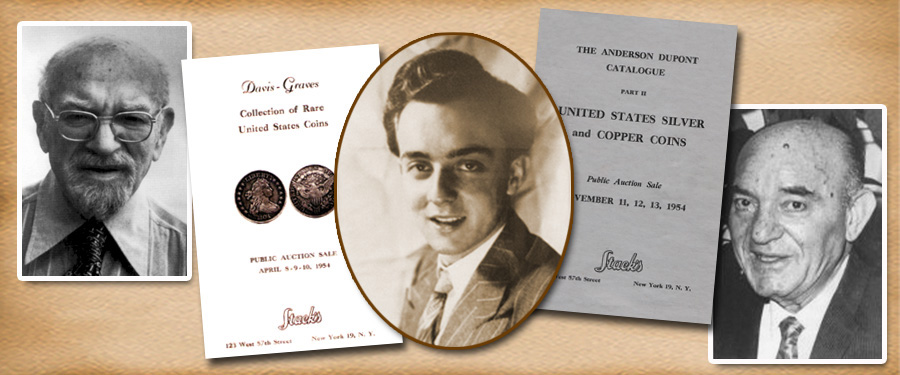
The year 1981 turned out to feature a few outstanding collections, a greater dedication at the ANA to stopping counterfeiting and "doctoring," and the stabilization of the silver market back at the original $10 per ounce. All this seemed to stimulate greater interest in numismatics, which had waned in 1980. This did not mean there were not challenges to deal with.
When the price of silver dropped on the world markets from over $50 per ounce to under $10 an ounce in a very short time, traders, speculators and coin collectors felt the sting. Speculators were forced to sell their "futures," the raw material they had bought on margin. Those who had counted on getting rich on the value of silver, were caught "short" and had to cover their losses by selling their collections or numismatic holdings. Many a bankruptcy occurred, and market confidence was damaged by all the forced sales. Such uncertainty in the metal markets of course had an effect on the rare coin market.
However, it is important to talk about the numismatic collectors who, as the market declined, either held on to what they had, or even were able to add to a cabinet at lower prices. For many collectors it was a time when collections grew in size and quality. It was an upsetting time to be a dealer. People did come in with their coins to sell (some which were influenced by the silver market), and others were scared that what they owned would lose even more value, There were people who wanted to get out of a hobby that was so susceptible to market variations that were based not on the scarcity of the items, but on the metal they were made of. Likewise, as a business, Stack’s had to watch the fluctuations of the metal markets and make buying decisions based on whether we would be able to resell the items without taking a loss.
We were concerned about our clients who had open accounts with us that might result in us sustaining a loss. The drop in value was ruthless, and many dealers and traders lost so much that they were forced to declare bankruptcy and there were shops and offices that closed.
Stack’s, like other dealers around the country, had a large, paid for inventory, and we decided to sit things out, keep our business alive, and to continue to serve our clients the very best we could. The retail business did drop, but our public auction business, which presented nine sales in 1981 did help keep things level, as scarce, rare and desirable coins came to market. To our surprise, collectors and dealers did attend the sales or mail in bid sheets, trying to acquire rare and nice coins from the collectors or estates that we were able to offer. So, we continued to serve both buyer and seller, although at lower levels than before. If speculators were still in the field, they were attracted to gold coins, for throughout history gold had been a stabilizing commodity. But every deal was a challenge, and there were many sleepless nights we all suffered during this period.
An additional challenge that arose during this time was a type of fraud that centered around the grading certificates issued by the American Numismatic Association Certification Service (ANACS). ANACS was providing a valuable service by reviewing coins and offering a professional opinion as to authenticity and grade, and helping collectors to avoid fake or doctored coins. When the service began, it gave buyers a feeling of confidence that they were getting what they paid for. The use of the published ANA grading standards meant that there was more consistency in grading opinions. When coins were sent into ANACS they were graded and sent back to the owner with a photograph and grade opinion.
However, after a year or so, it was realized that there was no way to "attach" the coin to the photo/grading certificate. A number of scoundrels realized that they could make money by submitting beautiful coins to ANACS, getting back a grade opinion that said it was a superior coin, and then selling this certificate with a lower quality coin. While the ANACS photographs were good quality, they did not necessarily show enough detail to stop this kind of swindling. Once they had used the certificate for a lower quality coin, the scoundrels could submit the high quality coin again and receive another certificate.
It was not long before the numismatic community learned of this practice, and many of the scammers’ victims lost money on their purchases. At the time there was not much that ANACS could do. The Professional Numismatists Guild spent much time trying to stop this form of stealing and had success in their endeavors. Some of the perpetrators were caught and some buyers got their money back. The practice continued, however, and it became evident that coin certification required more safeguards to protect the collector. In the mid 1980s, the Professional Coin Grading Service and the Numismatic Guaranty Corporation entered the coin certification field, changing it forever by placing the coins in plastic "slabs" with the grades on the labels. Eventually other grading entities, including ANACS, also followed this path, and people became more confident that they were getting what they paid for.
Of course, in 1981, there was a large number of professional numismatists and collectors who had the experience and expertise to know when a coin was graded correctly. It was as important as ever that collectors learn about coins and grading and deal with reputable sellers. Stack’s continued to serve retail and auction clients and offer the expertise that had been gained over decades and generations. Still, there was an underlying feeling of doubt that existed in the coin market, and this affected prices, even when items were from old time collections.





